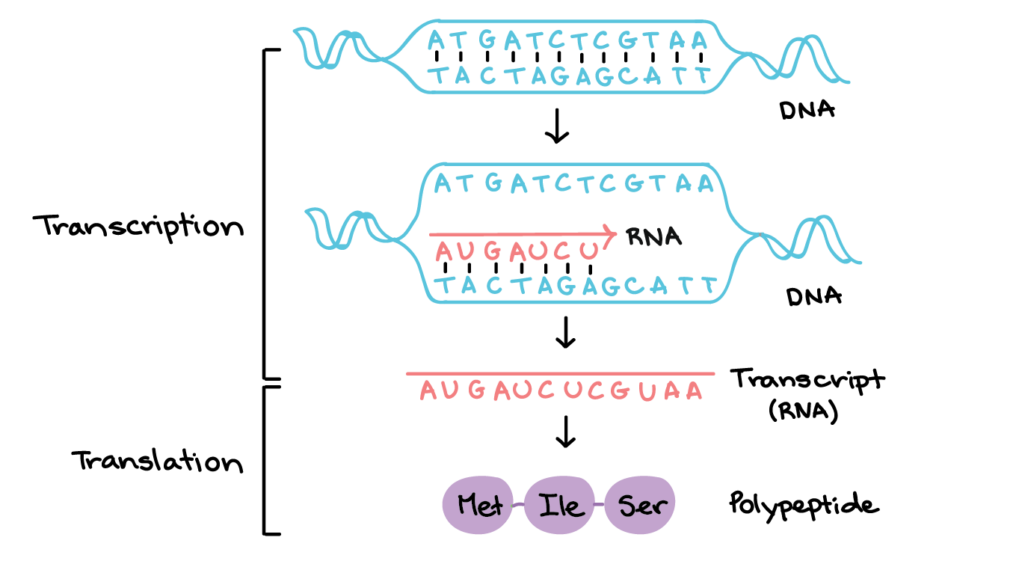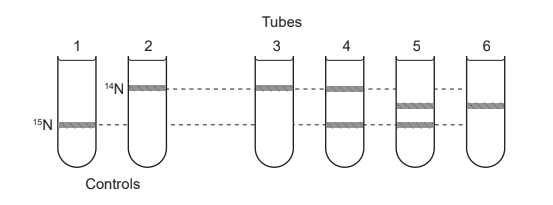IB Biology SL (Standard level)- 2024 – Practice Questions- All Topics
Topic 2.7 DNA replication, transcription and translation
Topic 2 Weightage : 20%
All Questions for Topic 2.7-Semi-Conservative, DNA Replication, polymerase chain reaction, Transcription, Genetic Code, Translation, Universality, Sequence Decoding, Central Dogma, Translation Analogy, Degeneracy, Point Mutations
What is required to replicate DNA?
A. Temperature of 37 °C
B. Free nucleotides carrying A, C, G and T bases
C. Plasmids
D. Endonuclease
▶️Answer/Explanation
Markscheme
B
During DNA replication, the two strands of DNA separate and serve as templates for making new complementary strands. An enzyme called DNA polymerase adds free nucleotides to the growing new strand according to the base pairing rules². For example, if the template strand has a T, the DNA polymerase will add an A to the new strand. This way, the sequence of nucleotides in the original strand is copied to the new strand. The free nucleotides are essential for this process because they provide the material for making new DNA strands that are identical to the original ones.
Question
What is formed during transcription?
A. RNA strand complementary to DNA strand, formed by RNA polymerase
B. DNA strand complementary to DNA strand, formed by DNA polymerase
C. RNA strand complementary to RNA strand, formed by DNA polymerase
D. DNA strand complementary to RNA strand, formed by RNA polymerase
▶️Answer/Explanation
Markscheme
A

During transcription, a DNA sequence is read by an RNA polymerase, which produces a complementary, antiparallel RNA strand called a primary transcript.
Question
Research has shown that the genetic code is not entirely universal. Which research finding has shown this?
A. Some amino acids are coded for by more than one codon.
B. There are differences between the base sequences of genes in different species.
C. In some organisms the genetic code for mitochondria differs from the genetic code for the nucleus.
D. Some codons code for the addition of an amino acid and some code for the termination of translation.
▶️Answer/Explanation
Markscheme
C
The genetic code is the set of rules that determines how the nucleotide sequence of DNA or RNA is translated into the amino acid sequence of proteins. The genetic code is not universal, meaning that different organisms may use different codes to specify the same amino acids.
Mitochondria are organelles that produce energy for the cell through oxidative phosphorylation. Mitochondria have their own DNA, separate from the cell’s DNA which is stored in the nucleus. Mitochondrial DNA (mtDNA) contains a handful of genes that code for some of the proteins needed for energy production. These proteins are made in the mitochondria themselves, and their levels are adjusted to meet the cell’s current energy needs.
The reason why some organisms have different genetic codes for mitochondria and nucleus is not fully understood, but it may be related to the evolutionary origin of mitochondria. Mitochondria are thought to have evolved from ancient bacteria that were engulfed by ancestral eukaryotic cells and established a symbiotic relationship². Over time, most of the bacterial genes were transferred to the nuclear genome, but some remained in the mitochondrial genome². The mitochondrial genes may have diverged from the nuclear genes due to different mutation rates, selection pressures, or genetic drift. Some of the differences in the mitochondrial genetic code may confer advantages for energy production or adaptation to different environments.
For example, in vertebrates, the mitochondrial genetic code differs from the standard genetic code in four codons: AGA and AGG code for stop instead of arginine, AUA codes for methionine instead of isoleucine, and UGA codes for tryptophan instead of stop². These changes may affect the efficiency or regulation
Question
This is a sequence of nucleotides from a section of mRNA.
AUGAAACGCACGCAG
From which DNA sequence has it been transcribed?
A. ATGAAACGCACGCAG
B. UACUUUGCGUGCGAC
C. TACUUUGCGTGCGTC
D. TACTTTGCGTGCGTC
▶️Answer/Explanation
Markscheme
D
Base pairing is the process of two nucleobases forming hydrogen bonds with each other in a double-stranded nucleic acid molecule, such as DNA or RNA⁴. Base pairing is important for the structure and function of DNA and RNA.
In DNA molecules, the base pairs are:
– Adenine (A) – Thymine (T)
– Cytosine (C) – Guanine (G)
In RNA molecules, the base pairs are:
– Adenine (A) – Uracil (U)
– Cytosine (C) – Guanine (G)
The difference between DNA and RNA base pairing is that DNA uses thymine while RNA uses uracil instead. This is because uracil is more stable than thymine in RNA, which is more prone to degradation by enzymes and chemicals.
Question
Bacteria cultured in a medium containing only  were transferred to a medium containing only
were transferred to a medium containing only  and allowed to complete one round of replication. The DNA in bacteria produced as a result of replication on the
and allowed to complete one round of replication. The DNA in bacteria produced as a result of replication on the  medium was extracted and subjected to caesium chloride centrifugation which separates DNA molecules according to their density.
medium was extracted and subjected to caesium chloride centrifugation which separates DNA molecules according to their density.

Which centrifuge tube shows the arrangement of bands observed after one round of replication?
Tube 3
Tube 4
Tube 5
Tube 6
▶️Answer/Explanation
Ans: D
According to Meselson-Stahl experiment, which was an experiment done by Matthew Meselson and Franklin Stahl in 1958 to test how DNA replicates. They used different isotopes of nitrogen to label the DNA of bacteria and observed how the DNA changed after several rounds of replication.
According to the semi-conservative model of DNA replication, which was supported by their experiment, each new DNA molecule consists of one old strand and one new strand. Therefore, if the bacteria were grown in heavy nitrogen for many generations and then grown in light nitrogen for many rounds of DNA replication, the configuration of DNA that will appear is a mixture of hybrid DNA (one heavy strand and one light strand) and light DNA (two light strands).
Question
A DNA triplet on the strand that is transcribed has the bases TAG. Which anticodon on tRNA is used in translation?
A. AUC
B. UAG
C. TAG
D. ATC
▶️Answer/Explanation
Ans:D
Both RNA and DNA share the nitrogenous bases adenine (A), guanine (G), and cytosine (C). However, DNA has thymine (T) as the fourth base, while RNA has uracil (U). These bases form complementary pairs that hold the two strands of DNA together or allow RNA to bind to DNA during transcription. The complementary pairs are A-T or A-U and G-C.
